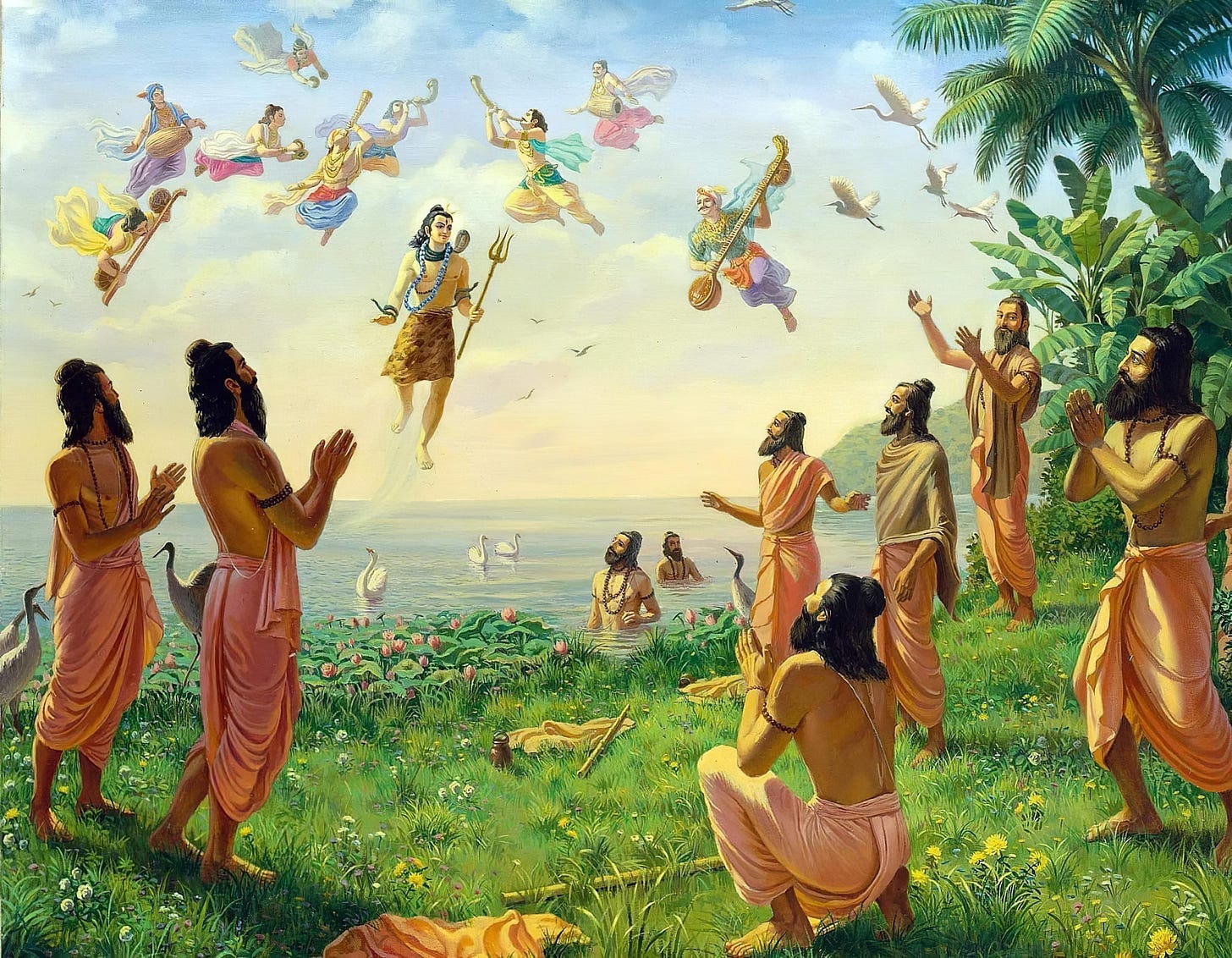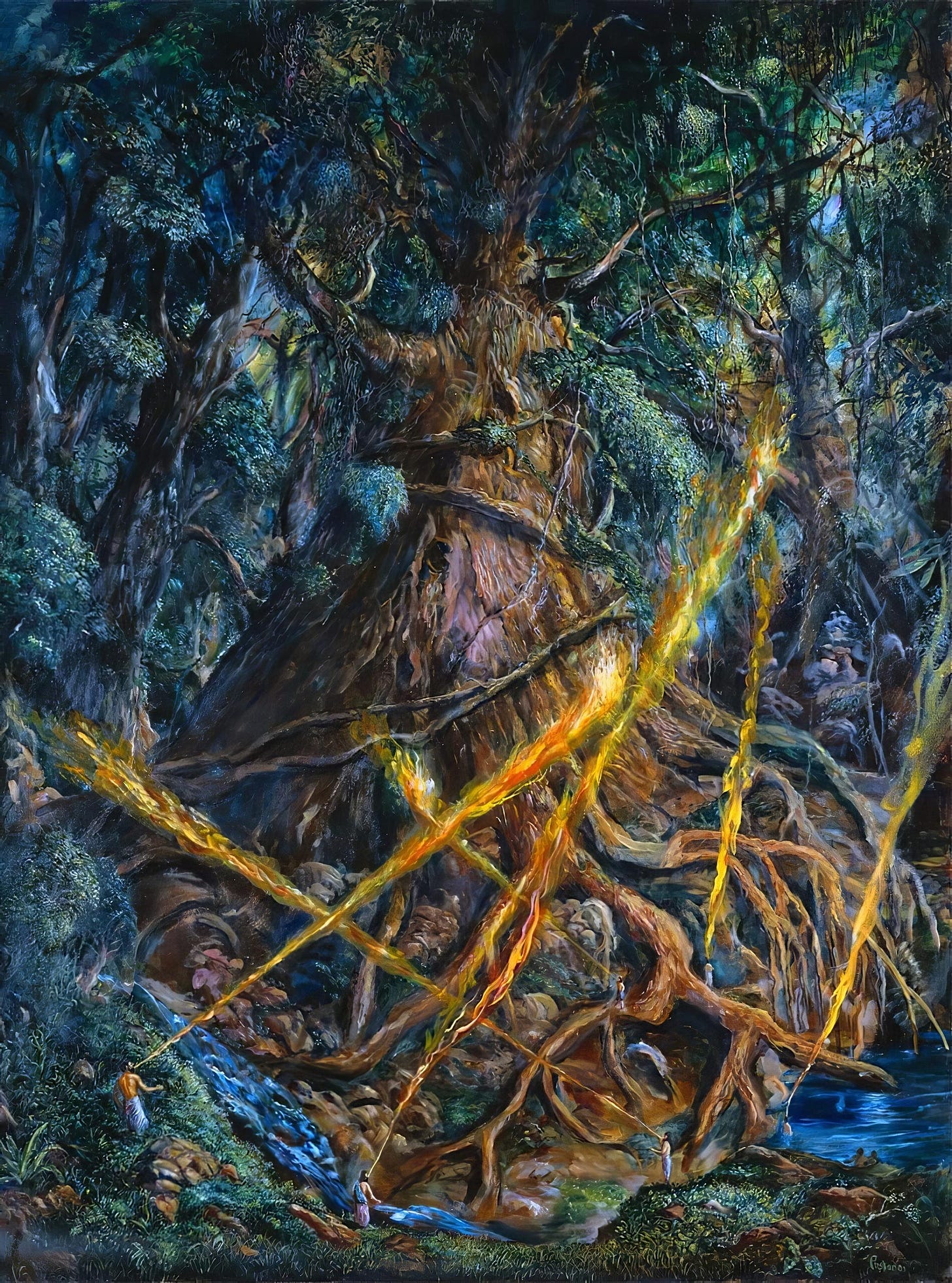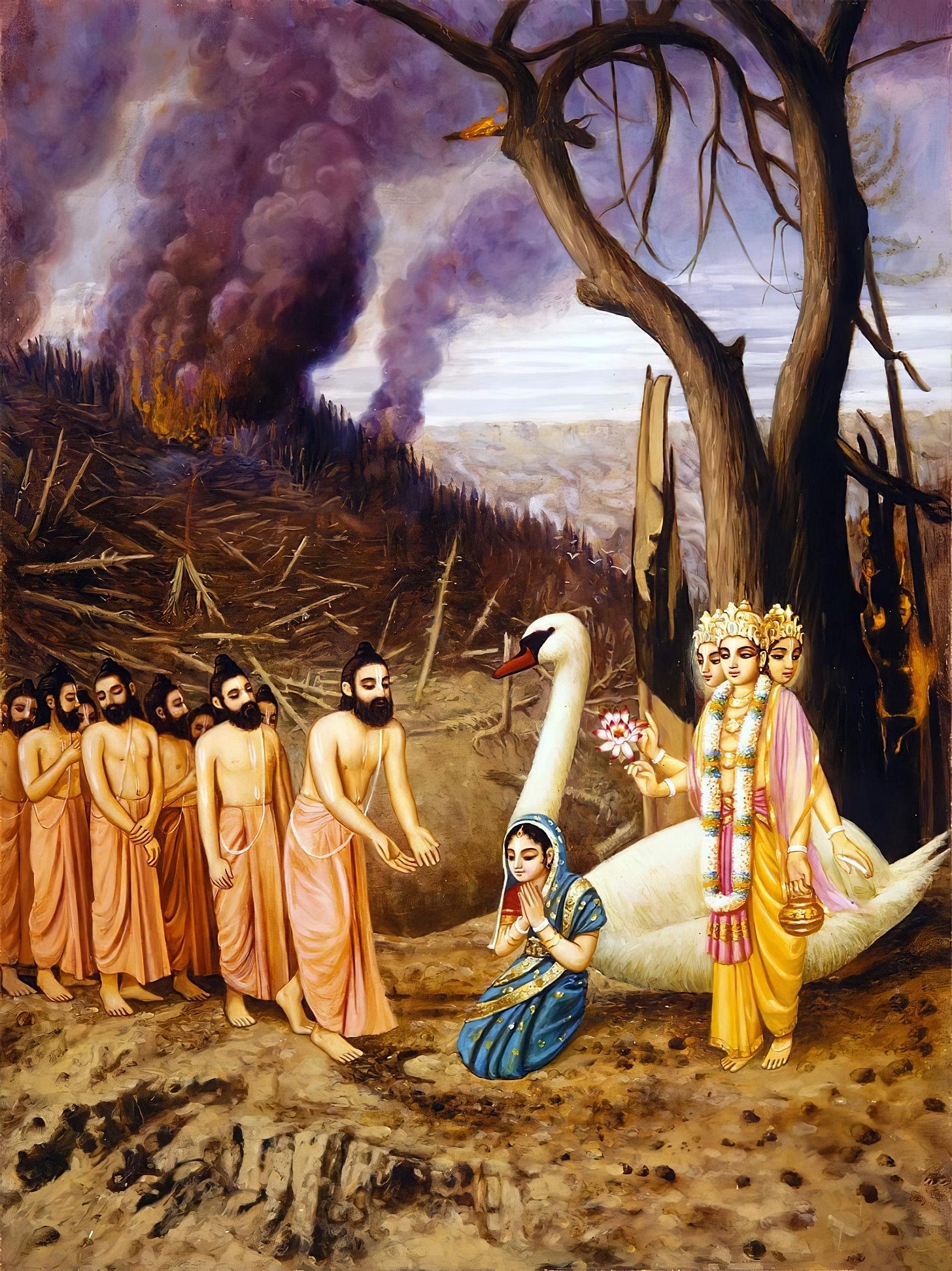The story of the Pracetās
Because Prācīnabarhi was so expert in the performance of sacrifices, Brahma himself arranged his marriage with Śatadruti, and on her he begot ten male children known as the Pracetās.
The story of Pṛthu Maharaja from the 4th canto of Srimad Bhagavatam is well known. Pṛthu was an empowered incarnation of the Lord (a saktiaveṣa avatara) empowered to rule as a perfect king. But what was his lineage, and how does his story connect with the Pracetas, another important pastime in the 4th canto?
After milking the Earth, ruling, and meeting the four Kumaras, Pṛthu Maharaja retired from his duties as king, went to practice austerities in the forest, and eventually returned home to Godhead.
Vijitāśva, the eldest son (the one who chased Indra when he was stealing the sacrificial horse), became the next king. He was also known as Antardhāna, because he received the power of appearing and disappearing at will from Indra, who became satisfied with him after he was able to detect him while stealing the horse from the sacrifice. He also made his brothers tributary kings of different parts of the world and thus shared the responsibility of ruling over the Earth with them.
He had three sons with his wife Śikhaṇḍinī: Pāvaka, Pavamāna, and Śuci. These three where not normal children, but fire gods who had been cursed by Vasiṣṭha. Even though taking birth as human beings, they conserved their power as demigods, and later returned to their positions by the strength of their yoga practice. He also had another child called Havirdhāna with his second wife, Nabhasvatī. Since the first three children returned to their posts as fire gods, Havirdhāna became the next king when his father retired from the administration at an still early age.
Although enjoying all the opulences of royal life, Antardhāna was internally not satisfied with the post. He was especially unhappy about his duties of collecting taxes, fining, and punishing citizens for their misdeeds. Therefore, as soon as Havirdhāna attained sufficient age, he retired under the pretext of performing sacrifices. Even though he was externally performing sacrifices, internally he was always practicing devotional service. Due to this fixed meditation, he easily returned back home, back to Godhead, just as his father.
Havirdhāna had six children with his wife, the eldest was Barhiṣat, or Prācīnabarhi, who became the protagonist of the last chapters of the 4th canto. The story of King Purañjana is an allegorical description of his life, created by Nārada Muni to invoke a spirit of renunciation in both the king and ourselves.
The story of the Pracetās
Prācīnabarhi was a very powerful king who excelled in the performance of sacrifices and the practice of mystic yoga. He even received the title of Prajāpati due to his extensive performance of sacrifices. As soon as he finished one yajña, he began performing another close by. These sacrifices were mainly fruitive, which led Nārada Muni to later give him spiritual instructions to bring him to the path of self-realization. However, in his purport, Prabhupada makes a parallel with the performance of saṅkīrtana-yajña. Just as Prācīnabarhi was performing sacrifices all over the world, we should perform saṅkīrtana all over the world, one kīrtana after the other, gathering thousands of people. This will bring imperceptible auspiciousness to the whole population, and gradually make them happy and Krsna conscious.
Because Prācīnabarhi was so expert in the performance of sacrifices, Brahma himself arranged his marriage with Śatadruti, the daughter of the predominating deity of the ocean, who was especially beautiful and qualified. On her, he begot ten male children, known collectively as the Pracetās.
The story of the Pracetās is unprecedented because they practiced austerities for 10,000 years inside the waters of the ocean, in some great bay or lake, where the waters were very peaceful. However, different from their father, who was performing fruitive sacrifices, they performed their austerities for the satisfaction of the Supreme Lord.
The story is that after his sons were sufficiently grown-up, Prācīnabarhi ordered them to marry and beget children, which also implied performing austerities, since without first properly purifying oneself, it is not possible to beget exceptionally good children as desired. The Pracetās accepted this order very obediently and left the palace to practice austerities. On the way, they met Lord Shiva, who, out of his great mercy, desired to give spiritual instructions to them. The instructions given by Lord Shiva are prayers called the Rudra-gita, in which the Pracetās meditated during their austerities in the water.
By the end of this period, they had the opportunity of meeting Lord Viṣnu, who appeared to them on top of Garuḍa, in a form with eight arms, and blessed them to marry a beautiful girl called Māriṣā, the daughter of the apsarā Pramlocā and the sage Kaṇḍu, who was raised by the trees, thanks to the mercy of Soma (who fed the child nectar coming from his finger). The Lord also blessed them to beget a qualified son who would fill the three worlds with population. More than that, the Lord blessed them to develop pure devotional service unto Him.
During the time the Pracetās were practicing their austerities, Prācīnabarhi continued ruling the kingdom. As these pastimes happened in Satya-yuga, he enjoyed a long span of life, and it would not be a problem to wait for 10,000 years for the return of his sons. However, in the meantime, Nārada Muni became compassionate in seeing that a descendant of Dhruva Maharaja was wasting his life in the performance of fruitive activities instead of worshiping the Supreme Lord. He thus visited the king to bring him back to his good senses by telling the allegory of Purañjana, which is in reality the story of the King himself, and in fact of every conditioned soul, struggling in this material world. By hearing this story, the king understood the futility of his fruitive performances and decided to leave to practice devotional service, without waiting for his sons.
Without a king, the Earth was neglected for several thousand years, and huge trees grew everywhere, covering the planet. When the Pracetās came out of the water, they became enraged at seeing the planet taken by trees in such a way. They were meant to rule the planet, and as we learned in the pastime of Pṛthu Maharaja, one of the main duties of a king is to be sure there is enough suitable space for agriculture. The anger of the Pracetās had thus a devotional background, because the trees were hampering their service to the Lord. They started producing wind and fire from their mouths, incinerating the trees. They were pacified by Brahma and later by Soma, who offered them Māriṣā in marriage, as predicted by the Supreme Lord. They begot a single son on her, Daksa (in his second birth). All of this happened in the first Manvantara.
However, Daksa was interested in regaining his role as a Prajāpati, and not in becoming an earthly king, and therefore he departed to perform austerities at a young age, before producing any descendants. Daksa produced many descendants, but much later, when he was reinstated in his post as a Prajāpati in the 6th Manvantara. With this, the lineage of Dhruva Maharaja was broken, leading Svāyambhuva Manu to request Priyavrata (his older son) to return from his austerities and take charge of the kingdom, as described in the 5th canto.
The talks between Nārada and Prācīnabarhi are described from chapter 4.25 to 4.29, the pastime of the Pracetās meeting Lord Viṣnu, burning the trees, and marrying Māriṣā is described in chapter 4.30, and their renunciation after entrusting their wife to their son, Daksa, is described in chapter 4.31. The story of the Pracetās is revisited later, in the 4th chapter of the 6th canto, in connection with the description of the Haṁsa-guhya prayers offered by Daksa to the Lord during his long meditation.




